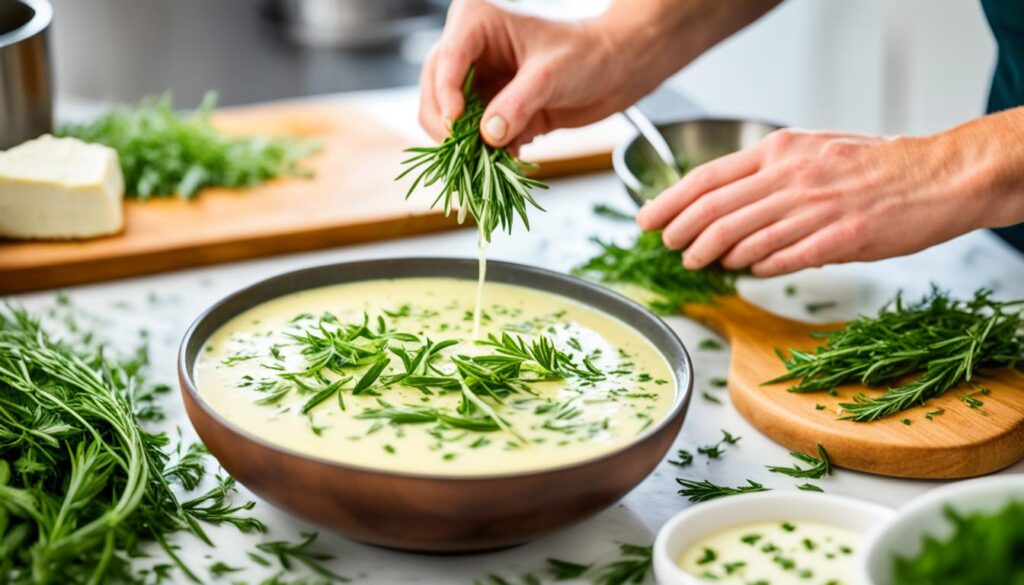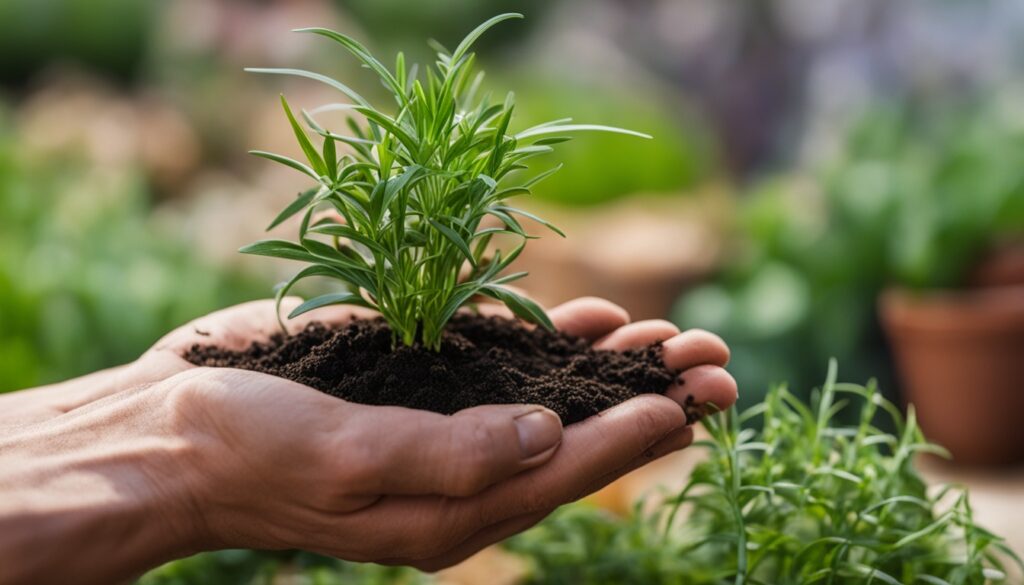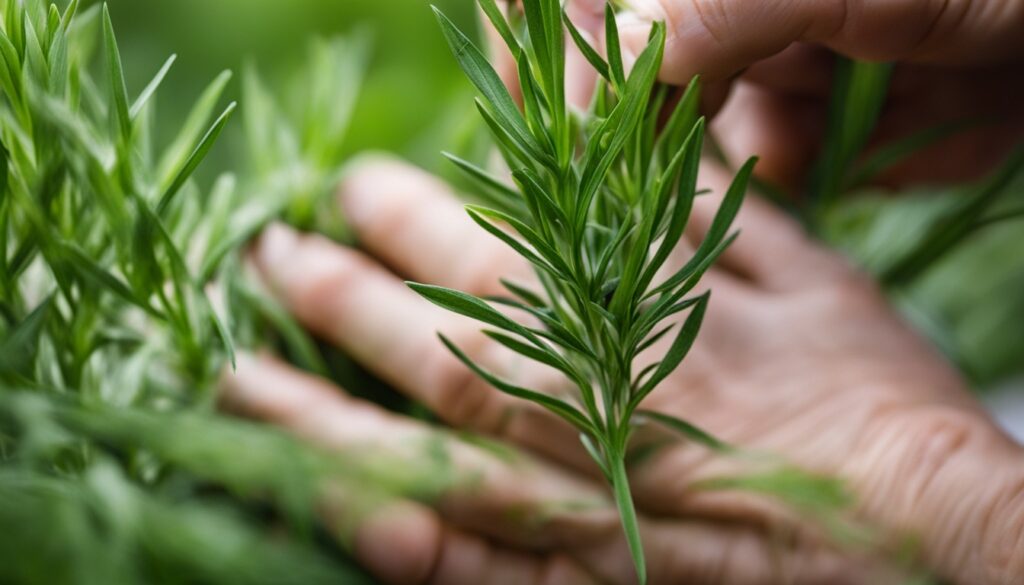Tarragon is a special herb that makes your cooking better. It tastes like licorice and is key in French cooking. Adding it to your dishes can turn simple meals into amazing ones.
This article will show you why tarragon is great. You’ll learn about its health benefits, types, and how to use it in cooking. It’s perfect for both expert chefs and kitchen beginners.
We’ll also talk about growing your own tarragon. It gives you fresh herbs and lets you control their quality. For a healthier diet, try adding more green leafy veggies. Learn about spinach’s health benefits here.
Introduction to Tarragon
The tarragon herb is a versatile plant used in many cooking traditions. It comes in two main types: French and Russian. French tarragon is known for its aromatic and slightly sweet taste. It’s often used in classic French dishes.
Russian tarragon has a milder flavor. This makes it good for a wide range of dishes.
This herb is key for making sauces, dressings, and marinades better. It can make any food taste better. You can find both types of tarragon in gardens and stores. This gives cooks at home and in restaurants a chance to use this great herb in their recipes.
Benefits of Growing Tarragon
Growing tarragon in your garden has many perks. It’s not just for its great taste. It’s a key part of your kitchen herbs.
Health Benefits of Tarragon
Tarragon is full of antioxidants and anti-inflammatory stuff. Eating it often can help with digestion. It’s good for your health, making it a top pick for those who care about their health.
Cost-Effective Culinary Use
Growing your own tarragon saves money in the kitchen. Fresh tarragon is expensive in stores. But with a little effort, you can have it at home. It makes your cooking better and helps your wallet too.
Understanding Different Types of Tarragon
Tarragon comes in several types, each with its own flavor and growing needs. Knowing the differences helps you pick the best one for your cooking. French and Russian tarragon are the most popular types, each with its own unique traits for different cooking needs.
French Tarragon vs. Russian Tarragon
French tarragon is known for its sweet, rich taste. It’s a top pick for gourmet cooking. It adds a delicate flavor to dishes, especially in French cuisine.
Russian tarragon has a milder taste and is simpler to grow from seeds. It’s good for casual cooking but doesn’t match the intensity of French tarragon. This can be important for fine dining.
Choosing the Right Variety for Your Cooking Needs
Choosing the right tarragon depends on your taste and how you plan to use it. For strong, flavorful dishes, French tarragon is best. It has a strong aroma that goes well with many ingredients.
If you want a milder flavor and easy growing, Russian tarragon might be for you. Remember, your cooking needs are key to this choice.
| Type of Tarragon | Flavor Profile | Growing Difficulty | Culinary Uses |
|---|---|---|---|
| French Tarragon | Sweet, rich | Moderate | Salads, sauces, gourmet dishes |
| Russian Tarragon | Milder, herbaceous | Easy | Casual cooking, herbal blends |
Knowing these differences helps you use tarragon well. This makes your dishes more flavorful and satisfying.
How to Use Tarragon in Your Dishes

Tarragon adds a unique taste to many dishes, making it a key herb in your kitchen. It can make your meals better, whether for a simple dinner or a big event. This part will show you how to add tarragon to your cooking.
Pairing Tarragon with Other Ingredients
Tarragon’s flavor goes well with many foods. Here are some great pairings:
- Chicken: Tarragon is great with chicken, especially thighs, which taste richer.
- Fish: It makes fish taste better by adding a fresh flavor.
- Vegetables: Adding tarragon to veggies makes them more interesting.
Things like lemon juice and vinegars are perfect with tarragon. They bring out its bright taste. Using these in your cooking shows how versatile tarragon is.
Incorporating Tarragon in Everyday Cooking
Using tarragon in daily cooking can make your meals special. Here are some ideas:
- Season Soups: Tarragon can make broths and soups taste amazing.
- Dressings and Marinades: Add it to vinaigrettes or marinades for chicken or veggies to boost the flavor.
- Salads: Mix fresh tarragon into salads or grain bowls for a nice touch.
As you try cooking with tarragon, you’ll see how it can make many dishes tastier and more memorable.
| Ingredient | Pairing Suggestions |
|---|---|
| Chicken | Tarragon makes chicken dishes, especially thighs, taste better. |
| Fish | It’s perfect with fish, adding a fresh taste. |
| Vegetables | Seasonal veggies get a unique flavor from tarragon. |
| Lemon Juice | It highlights tarragon’s taste and adds a nice acidity. |
| Vinegars | It goes well with tarragon, making dressings and marinades better. |
Tarragon Recipes for Home Cooks
Tarragon is a special herb that brings a unique taste to many dishes, especially in classic French cooking. Using tarragon recipes can make your meals better and introduce you to new flavors. Here, you’ll find some famous French dishes with tarragon and easy recipes for home cooks.
Classic French Dishes Featuring Tarragon
Classic French dishes often use the rich taste of tarragon. Two top recipes are:
- Chicken Tarragon: This dish combines tender chicken, creamy dressing, and the unique taste of tarragon. It’s a tasty choice for any meal.
- Béarnaise Sauce: A rich, buttery sauce for steak, Béarnaise sauce uses tarragon for its special flavor. It’s a key part of French cooking.
Adding tarragon to these dishes deepens their flavors and connects you to French cooking’s rich tradition.
Simple Tarragon-Infused Recipes
For easy tarragon recipes, try these simple ideas:
- Tarragon-Infused Oil: Great for drizzling on salads or finishing dishes, this oil is made by mixing olive oil with fresh tarragon. Let it steep for a few hours.
- Tarragon Vinaigrette: Make a quick vinaigrette with olive oil, vinegar, minced tarragon, and a bit of mustard. It adds a fresh, zesty taste to salads.
These recipes let you add tarragon to your cooking easily. They boost the flavors of your meals without much work.
Growing Tarragon in Your Garden

Creating a thriving tarragon garden takes careful planning and regular care. Knowing how to set up and maintain your garden ensures strong growth and tasty leaves. Follow these simple steps to grow this fragrant herb in your backyard or on your balcony.
Setting Up Your Tarragon Garden
Choosing the right spot for your tarragon is key. Use containers that are at least 12 inches wide and deep for best results, especially if you’re growing indoors. A good potting mix, like John Innes No. 3 compost, helps prevent soil problems. Aim for a soil pH between 6.5 and 7.5 for the best tarragon growth.
Light is crucial for your tarragon garden’s success. Your plants need at least six hours of direct sunlight each day. Place your containers in a spot that gets plenty of sunlight and warmth.
Care and Maintenance for Healthy Growth
Regular watering is vital for your tarragon. Keep the soil moist but don’t overwater to prevent root rot. Feed your indoor plants with fertilizer every 4-6 weeks during the growing season. This helps them grow strong and taste better.
Pruning and pinching back your tarragon plants keeps them bushy and encourages new leaves. Start harvesting leaves 6-8 weeks after planting, cutting just above a leaf node. This way, you’ll keep your plants productive. Always check your plants for pests like aphids and spider mites, especially indoors.
By following these steps, you’re on your way to growing tarragon successfully. With proper care and a well-planned garden, you can enjoy this herb in your cooking for years. For more on the health benefits of herbs, check out this useful resource.
Tarragon Substitute Options
When you can’t find fresh tarragon, finding good substitutes is key. Knowing when to use them helps keep your dishes special. Here are some top substitutes for different recipes.
When to Use Substitutes
Use tarragon substitutes if you’re out of tarragon or if it doesn’t fit your diet. For example, if you’re making a dish that needs tarragon and you’re low on it, try fennel fronds or oregano. They taste similar and work well in savory dishes.
When making sauces or marinades, picking the right substitutes is important. It helps keep your dish’s flavor while using what you have at home.
Best Substitute Ingredients
Fennel fronds are a great substitute for tarragon because they taste similar and are easy to find. Dried oregano and fresh basil can also work, but they taste a bit different. Start with a little and adjust to taste.
Here’s a quick look at the best tarragon substitutes:
| Substitute Ingredient | Flavor Profile | Best Uses |
|---|---|---|
| Fennel Fronds | Sweet, anise-like | Salads, dressings, sauces |
| Dried Oregano | Earthy and robust | Pasta dishes, marinades, roasted meats |
| Fresh Basil | Sweet and aromatic | Italian cuisine, salads, soups |
| Dill | Crisp and fresh | Fish dishes, pickles, salads |
Trying out these ingredients can make cooking more fun. For more ideas, check outthis recipe or learn about ingredient versatility atthis guide.
Culinary Uses of Tarragon Seasoning
Tarragon is a star in the kitchen for its special taste. It’s not just for garnishing. Adding tarragon seasoning can make your cooking better. It goes well with herbs like basil and thyme, making flavors pop.
Seasoning Blends and Tarragon
Adding tarragon to seasoning blends makes dishes taste better. Mix it with herbs like basil, rosemary, and thyme for a unique flavor. Tarragon can turn simple meals into something special.
Try mixing tarragon with garlic and lemon zest for a zesty seasoning. It’s great on grilled veggies or roasted chicken.
Tarragon in Marinades and Dressings
Tarragon is key in marinades and dressings. It makes flavors better and helps meat get tender. Mix it with olive oil, vinegar, and mustard for a tasty vinaigrette.
This dressing is perfect for salads and grilled foods. Tarragon adds a fresh twist to homemade dressings and marinades. A simple marinade with tarragon, garlic, and white wine vinegar can make chicken or fish taste like gourmet.
Look at how top Paris restaurants like Le Gabriel use tarragon. These chefs show how tarragon can make dishes both tasty and creative.
Preserving Your Homegrown Tarragon
To keep the unique taste of tarragon all year, try drying or freezing it. These methods keep its flavor and smell bright.
Drying and Freezing Techniques
Drying tarragon is easy. Just hang the leaves in small bunches in a spot away from the sun. Or, use a dehydrator for a faster way.
Freezing tarragon keeps its taste great. Chop the leaves and put them in ice cube trays with water. Then, freeze them. This makes adding tarragon to dishes easy later.
Using Fresh Tarragon in Cooking
Fresh tarragon adds a special flavor to your food. It tastes like anise and makes dishes smell better. Use it with chicken, fish, or in salad dressings for a tasty meal.
For the best flavor, add fresh tarragon near the end of cooking. This lets it add flavor without cooking the leaves too much.
Tips for Cooking with Tarragon

Tarragon adds a special flavor to dishes. It’s important to balance its strong taste with other ingredients for great results. Here are some tips to help you use tarragon well.
Balancing Flavors with Tarragon
When adding tarragon to your dishes, it’s key to balance the flavors. Tarragon has a bold taste that can take over if you’re not careful. Here’s how to avoid that:
- Start with small amounts. Just a 1/4 teaspoon of dried tarragon can complement many recipes.
- Pair it with milder ingredients such as potatoes, peas, or chicken to enhance their natural flavors.
- Combine tarragon with other fresh herbs like basil or thyme, creating a more complex flavor without overpowering your main ingredients.
Enhancing Dishes with the Right Amount
Getting the right amount of tarragon is crucial for the best taste. Here are ways to use tarragon to make your dishes shine:
- Use tarragon as a garnish to add a fresh touch to finished dishes.
- Try sautéing vegetables or proteins with a tablespoon of tarragon for an aromatic lift.
- Adjust the quantity based on dish size; for larger portions, consider using up to 1 teaspoon of fresh tarragon.
Remember, using tarragon in moderation can really elevate your cooking. Use it thoughtfully to create meals that highlight its unique flavor. With these tips, you’ll be great at adding tarragon to your dishes.
Why Tarragon is Essential for Gourmet Cooking
Tarragon is key in gourmet cooking. It makes flavors better and adds depth to dishes. It tastes like anise and is loved by top chefs in fancy Paris restaurants. They use it in sauces, marinades, and dressings to make food special.
Chefs choose tarragon for its great taste and health benefits. It’s found in dishes at top restaurants. Tarragon makes simple dishes turn into amazing meals. It shows how important tarragon is in gourmet cooking.
When you cook, the right ingredients matter a lot. Using tarragon in your recipes brings the taste of fine dining to your table. Tarragon makes your dishes special and memorable.



